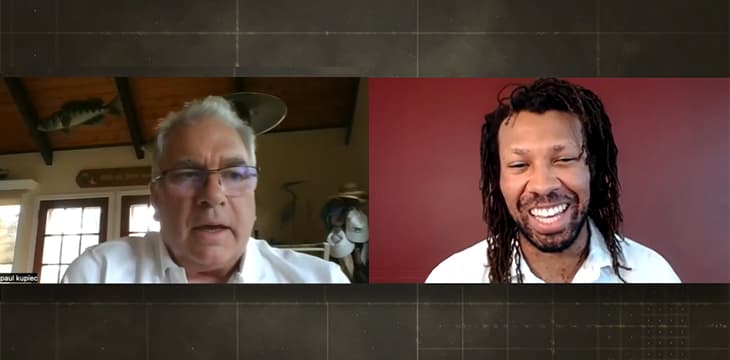|
Getting your Trinity Audio player ready...
|
Paul Kupiec is a senior fellow at the American Enterprise Institute. This week, he joins Patrick Thompson on CoinGeek’s More Than Money to talk about stablecoins, public ledgers, the Federal Reserve Digital Currency (FRDC), and more.
Who is Paul Kupiec?
Kupiec is an economist and a senior fellow at the American Enterprise Institute. After completing his Ph.D., he started teaching at NC State University before moving to the Federal Reserve Board, where he worked with Alan Greenspan and others.
After his stint at the Fed, Kupiec moved to Wall Street, working for JPMorgan and Freddie Mac before moving to the International Monetary Fund (IMF) and then the Federal Deposit Insurance Corporation (FDIC). That’s quite a background in banking regulation, securities market issues, and financial markets.
After spending lots of time thinking about how digital currencies and blockchain technology fit into the traditional financial system, he believes that “public distributed ledgers are a new way to clear and settle payments.”
On a Federal Reserve Digital Currency
Thompson asks Kupiec for his thoughts on the so-called Federal Reserve Digital Currency. He wants to know if this would be a Federal Reserve version of a CBDC.
Kupiec says it would essentially be the same as the bank reserves the Federal Reserve issues to collateralize banks. Right now, the Fed is exploring whether to make the same sort of thing available to the public. He says that the benefits and risks of the FRDC are being weighed up after President Joe Biden’s executive order earlier this year.
Thompson asks Kupiec if such an innovation would pose a risk to the existing system? He answers that there are two camps or schools of thought about this. “It’s split on the hill,” he says, explaining that some in government see and emphasize the risks while others focus on innovation.
In Kupiec’s view, the FRDC would be different from private stablecoins and other such assets because it is a liability of the Federal Reserve itself, and they can always print the money needed to back it. However, while he believes it would be “risk-free,” he does not believe the FRDC would trade on a public digital ledger.
Web 3.0 and the Internet of Things
Thompson shifts gears, asking Kupiec to define Web 3.0. He points to a recent article Kupiec wrote and asked him to describe what his vision of Web 3.0 is.
Kupiec sums it up as the “Internet of Things.” He mentions smart appliances, how they’ll be connected, and how they’ll be able to automate processes such as ordering groceries and paying for them when supplies are low. He believes that so-called ‘smart contracts’ will streamline many burdensome processes, unleashing new efficiencies in different industries like shopping and supply chains.
A unified system, blockchain technology, and energy efficiency
Thompson points out that the situation in the digital currency industry right now is a lot like the ‘WildCat’ era of banking; lots of people are using different tokens and coins, and many of them aren’t widely accepted. He asks Kupiec if, at some point, the world will have to decide on one stablecoin or CBDC.
Kupiec answers in the affirmative. He believes that value will settle on one standardized blockchain, eliminating the problem of interoperability. He predicts that there will be one standardized digital public ledger and that it will be much more energy efficient than the current candidates.
Thompson presses him on what specs the blockchain he imagines would need to have. Kupiec admits that he’s not an expert in this field, but he believes it may be a proof-of-stake system or even more energy-efficient. He also believes that any such system will start with a dollar-based stablecoin as the primary medium of exchange. He notes that there are still many problems to solve before this system can become a reality, but these will be solved by a combination of intelligent people and vast quantities of money.
Thompson zooms in on the idea that proof-of-work blockchains are energy-intensive and asks whether Kupiec believes there’ll be a shift away from them in favor of something else? Kupiec says that PoW is too energy-intensive but doesn’t know what the solution is. It could be proof-of-stake, or it could be something that’s being worked on but isn’t widely known about yet. Aside from energy efficiency, he believes that blockchains and public ledgers aren’t widely trusted yet, and that needs to be worked on before any system built on them enjoys widespread adoption.
Coming to a close, Thompson asks what other issues need to be overcome, and Kupiec answers that legislation is the main thing. He notes how private stablecoins remain primarily unregulated, how DAOs operate like corporations but aren’t treated as such under the law, and how exchanges like Coinbase (NASDAQ: COIN) don’t segregate user accounts so their assets can be used in the event of bankruptcy. He reminds us that the current financial system had to face the same challenges and that they were eventually worked out.
As a final message, Kupiec reminds viewers that this is all very new, that there are risks involved, and that they should be careful what they put their money into.
Watch: The BSV Blockchain Convention panel, The Future of Financial Services on Blockchain: More Efficiency & Inclusion
https://youtu.be/RzJsCRb6zt8?t=10941

 12-23-2025
12-23-2025 




